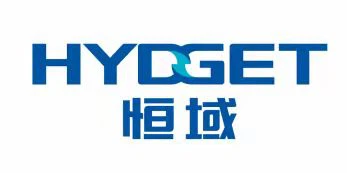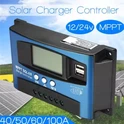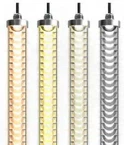
1. Transformer Basic Knowledge
1.1 Transformer Definition & Role
The transformer is a relatively static electrical equipment, by winding in the same core of two or more windings, the windings through the alternating magnetic flux between the interconnection. In order to send out the power plant economic transmission of electricity, reasonable distribution and safe use, are used to power transformers.
1.2 Transformer Working Principle
Simply put, the working principle of transformer is "electricity generates magnetism, magnetism generates electricity". The primary (primary) coil and secondary (secondary) coil of the transformer are wound together on a core, and when the primary coil is fed with voltage U1, an alternating magnetic flux is generated in the core, which passes through the primary winding and secondary winding, and according to the law of electromagnetic induction, the induced potential E1 and E2 are generated in the primary and secondary windings respectively.
According to the law of electromagnetic induction, the induced potential of the primary and secondary side windings are
E1/E2=U1/U2=N1/N2=K (k is the ratio of variables)

1.3 The basic composition of the transformer
Oil-immersed transformers are usually composed of seven parts, as follows:
Iron core section
High-quality grain-oriented cold-rolled steel or amorphous alloy material with a thickness of less than or equal to 0.3 mm is used, mainly as a skeleton.

Winding section
It is usually wound with high-quality first-class oxygen-free copper wire, which is the heart of the transformer.

Oil tank section
Oil-immersed transformers are usually equipped with oil tanks, including oil conservators, brackets, etc.

Insulation section
Includes transformer oil, paper insulation and internal insulation construction.

Measuring instrument section
Including thermometers, oil level gauges, etc.

Cooling system section
Including cooler or radiator, oil pump, fan, etc.


Protection device section
Pressure releasers, gas relays, moisture absorbers, etc.

Dry-type transformers are usually composed of four major parts, as follows:
Iron core section
Winding section
Cooling system section
Measuring instrument section
1.4 Transformer structure schematic diagram
Three-phase oil-immersed power transformer shape diagram

Dry type power transformer shape diagram

2. Classification of transformers
There are four main types of transformers:
Distribution transformers
Oil-immersed transformers
Dry-type distribution transformers
Amorphous alloy distribution transformers
Distribution transformers: step down from higher voltage to the final distribution voltage and are used directly for distribution.

Oil-immersed transformers: transformers with core and windings immersed in oil.

Dry-type distribution transformers: transformers in which neither the core nor the windings are immersed in an insulating liquid.

Amorphous alloy distribution transformers: distribution transformers using cores made of amorphous alloy strips with soft magnetic properties as the permeable material.

2.1 Transformer classification by application
2.1.1 Step-up transformer
Step-up transformer refers to the voltage instant start, at present, the domestic transformer manufacturers can effectively do instant boost is relatively rare, boost transformer instant start boost ability is relatively strong, boost effect is better.
It differs in that the non-excited regulator switch does not have the ability to change gears with load, because this tap changer in the process of changing gears, there is a short time disconnection process, disconnecting the load current will cause arcing between contacts burned tap changer or short circuit, so the transfer gears must make the transformer power off. Therefore, generally used for the voltage requirements are not very strict and do not need to frequently adjust the gear transformer.
2.1.2 Step-Down Transformer
Step-down transformer is a transformer that takes a higher voltage at the input and
converts it into a relatively low ideal voltage at the output, thus achieving the purpose
of voltage reduction.
2.2 Transformer classification by number of phases
2.2.1 Single-phase transformers
Single-phase transformers are transformers in which both the primary and secondary
windings are single-phase windings.

2.2.2 Three-phase transformer
Three-phase transformer is a combination of three single-phase transformers of the same capacity. It has three core columns, each of which is wound with two coils of the same phase, one for the high voltage and the other for the low voltage.

2.3 Transformer classification by cooling method
Dry air self-cooling
Dry cast insulation
Oil-immersed self-cooling
Oil-immersed air-cooled
Oil-immersed water-cooled
Forced oil circulation air-cooled
Forced oil circulation water-cooled

2.4 Transformer classification by regulating mode
Non-excitation voltage regulation
On-load regulation
3. Common technical parameters of transformers
Rated capacity (kVA): rated voltage. The capacity that can be provided incontinuous
operation at rated current.
Rated voltage (kV): The working voltage that the transformer can withstand in long-term operation. In order to meet the needs of grid voltage changes, the high-voltage side of the transformer is provided with a tap, and the output voltage of the low-voltage side is adjusted by adjusting the number of turns of the high-voltage winding.
Rated current (A): The current that the transformer is allowed to pass for a long time under the rated capacity.
No-load loss (kW): The rated voltage of the rated frequency is applied to the terminals of one winding, and the active power absorbed by the remaining windings is open. It is related to the performance and manufacturing process of the iron core silicon steel sheet, as well as the applied voltage.
No-load current (%): The current passing through the primary winding when the secondary side of the transformer is no-load at the rated voltage. Generally expressed as a percentage of rated current.
Load loss (kW): Short-circuit the secondary winding of the transformer and pass the rated current through the rated tap position of the primary winding, that is, the power consumed by the transformer at this time.
Impedance voltage (%): Short-circuit the secondary winding of the transformer and slowly increase the voltage in the primary winding. When the short-circuit current of the secondary winding is equal to the rated value, the voltage applied to the primary side at this time. Generally expressed as a percentage of rated voltage.
Phase number and frequency: three-phase starts with S, single-phase starts with D.
Temperature rise and cooling: The difference between the transformer winding or oil temperature and the ambient temperature around the transformer is called the winding or oil surface temperature rise. The oil-immersed transformer winding temperature rise limit is 65K, and the oil surface temperature rise is 55K. There are also various cooling methods: oil immersion self-cooling, forced air cooling, water cooling, tube type, sheet type, etc.
Insulation grade: There are insulation grade standards. An example of the insulation level representation method is as follows: the insulation level of a transformer with a high voltage rated voltage of 35kV and a low voltage rated voltage of 10kV is represented by LI200AC85/LI75AC35, where LI200 indicates that the high voltage lightning impulse withstand voltage of the transformer is 200kV, and the power frequency withstand voltage is 200kV. It is 85kV, the low-voltage lightning impulse withstand voltage is 75kV, and the power frequency withstand voltage is 35kV.
Connection group label: The transformer windings are connected into various combinations according to the phase relationship of the transformer 1. The secondary winding is called the connection group of the windings. In order to distinguish different connection groups, the clock symbol is often used, that is, the phasor of the high-voltage side line voltage is used as the long needle of the clock, which is fixed at 12 o'clock, and the phasor side line voltage of the low-voltage side line voltage is used as the short needle of the clock. See where the short needle points. Numbers are used as labels for connected groups. For example, Dyn11 indicates that the primary winding is (delta) connection, the secondary winding is the center point (star) connection, and the number of groups is (11) points.







